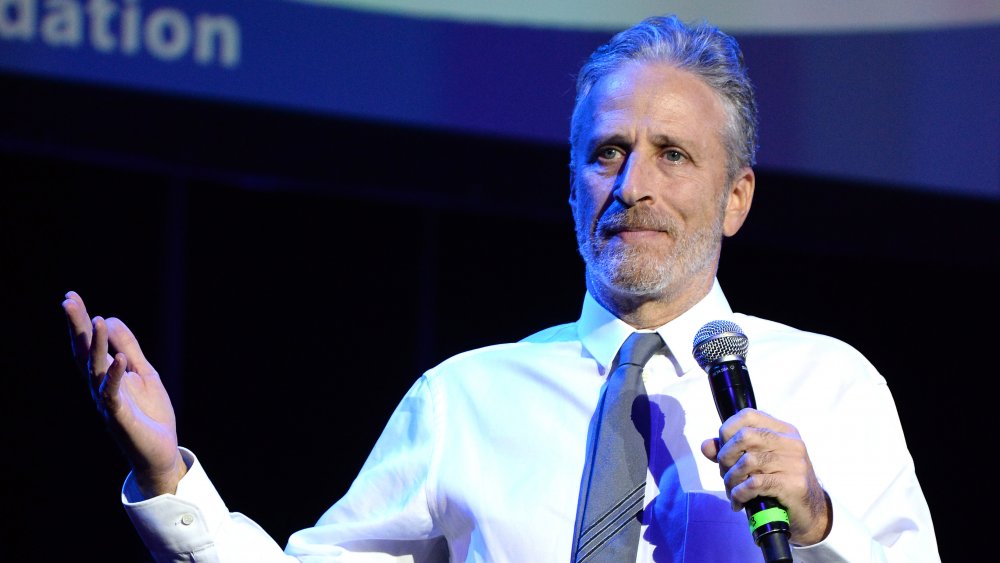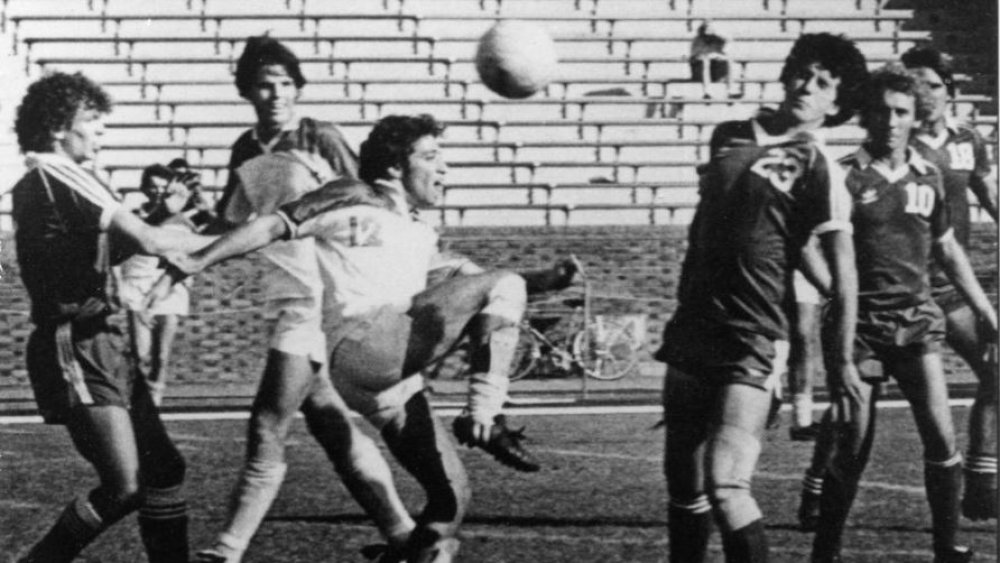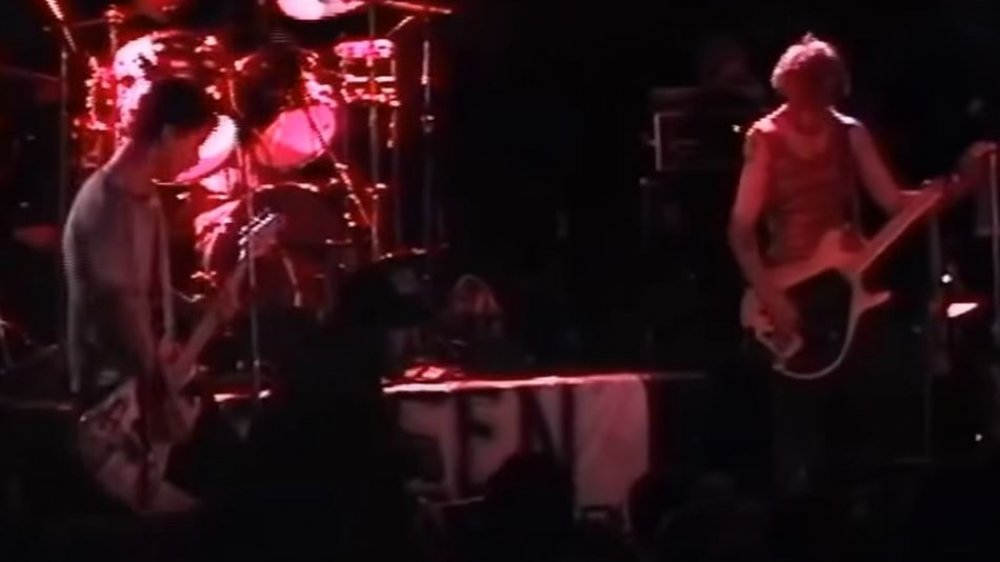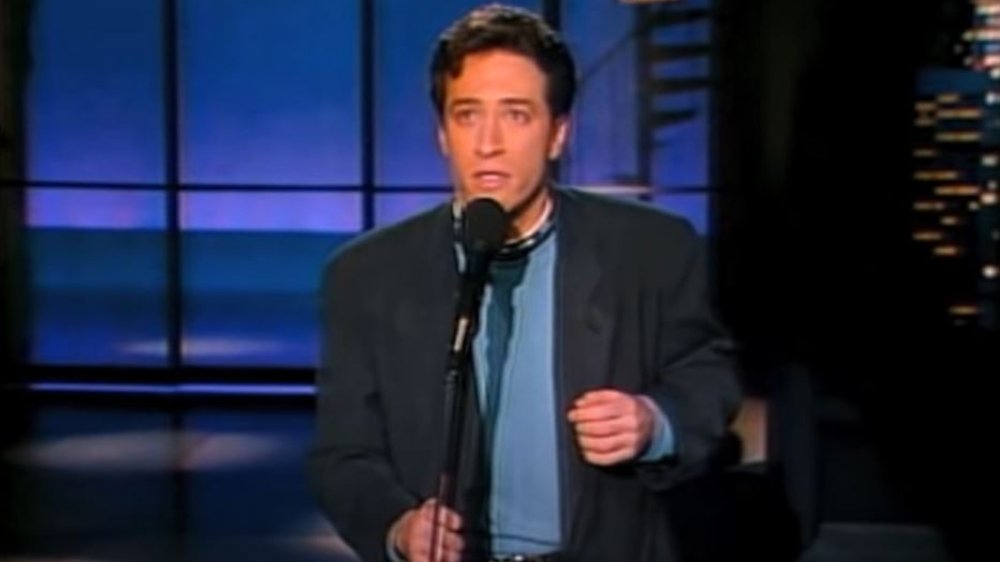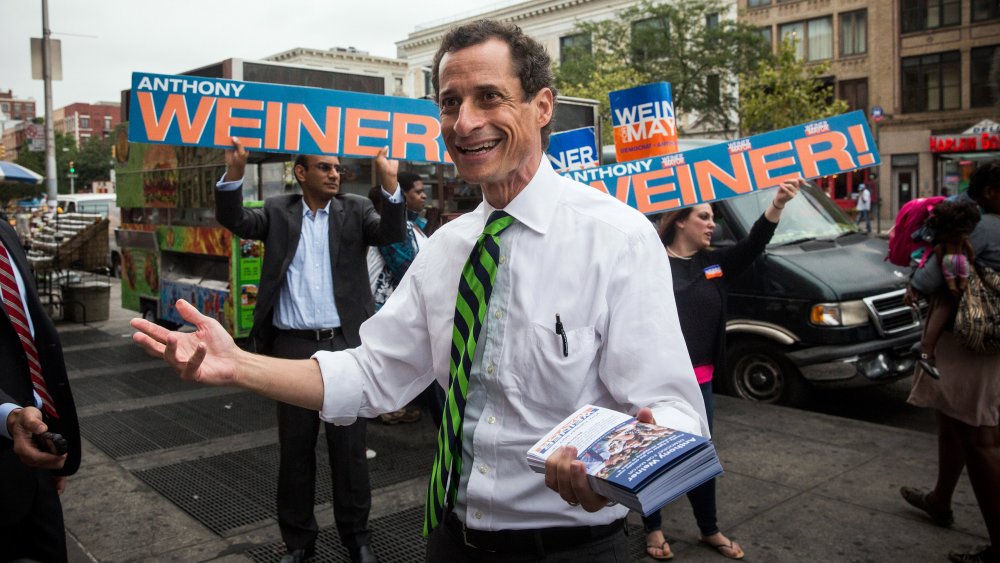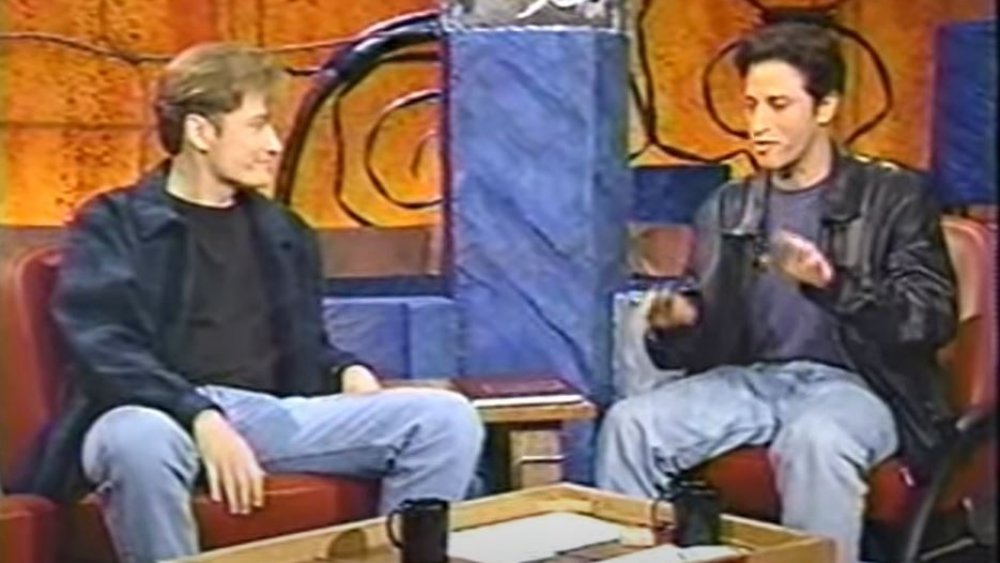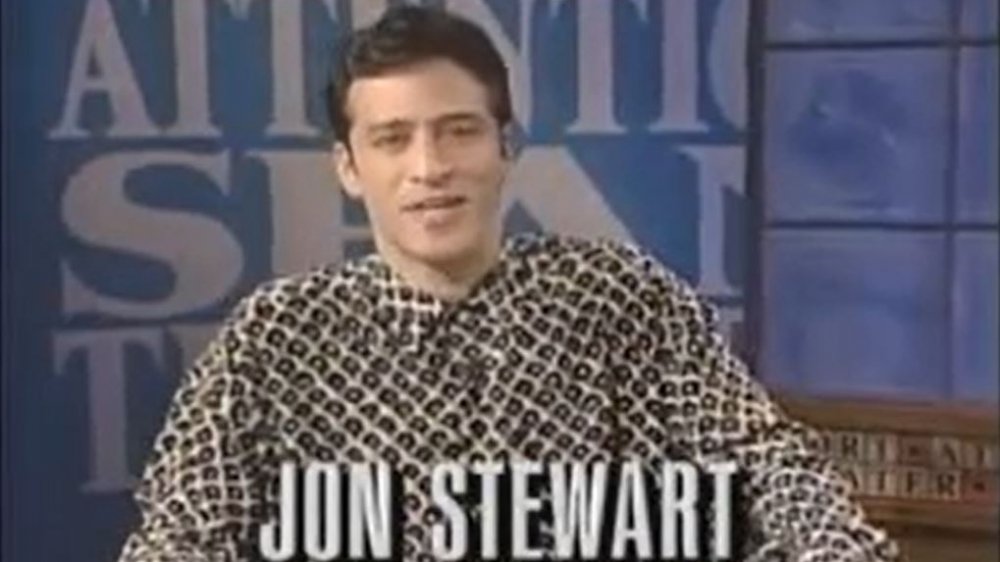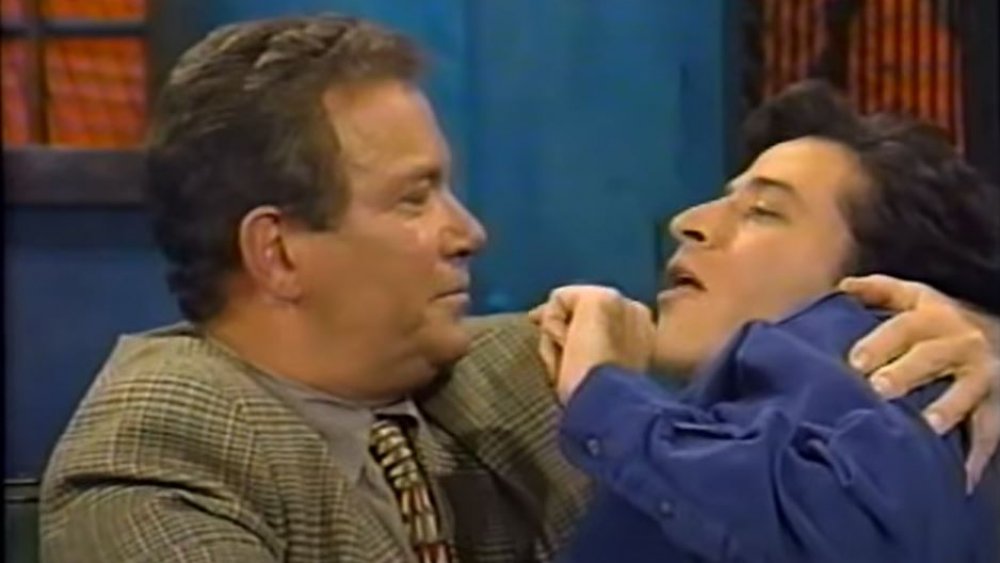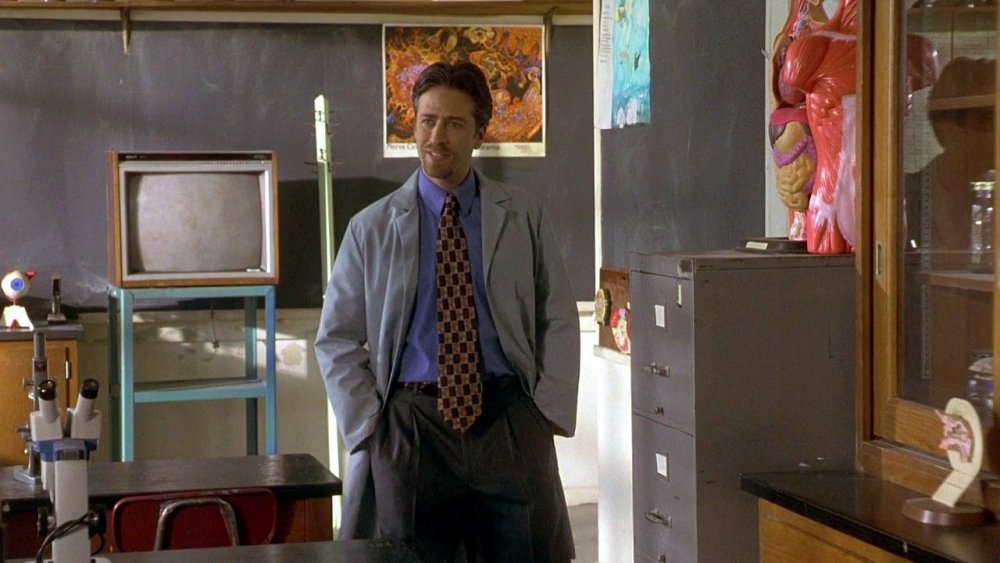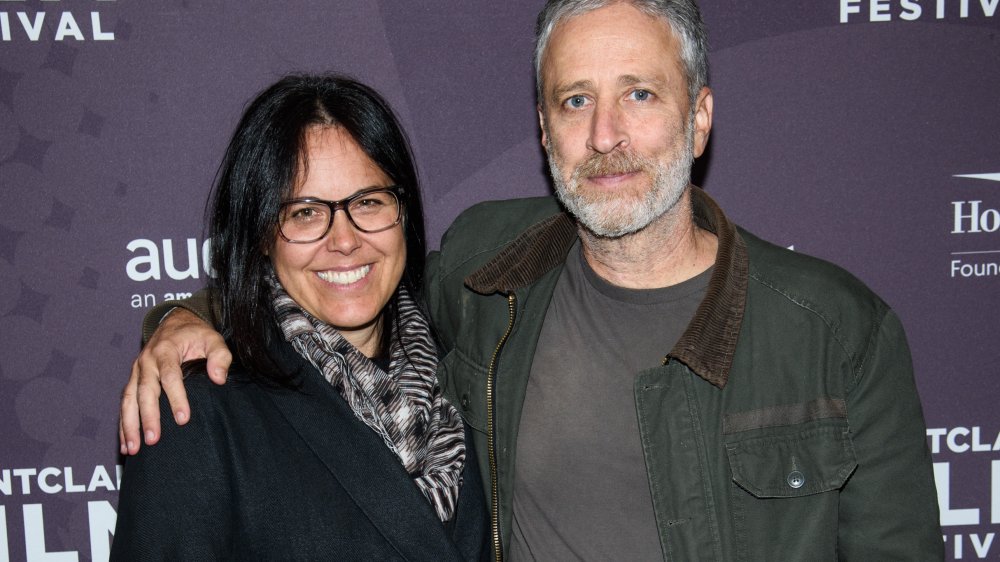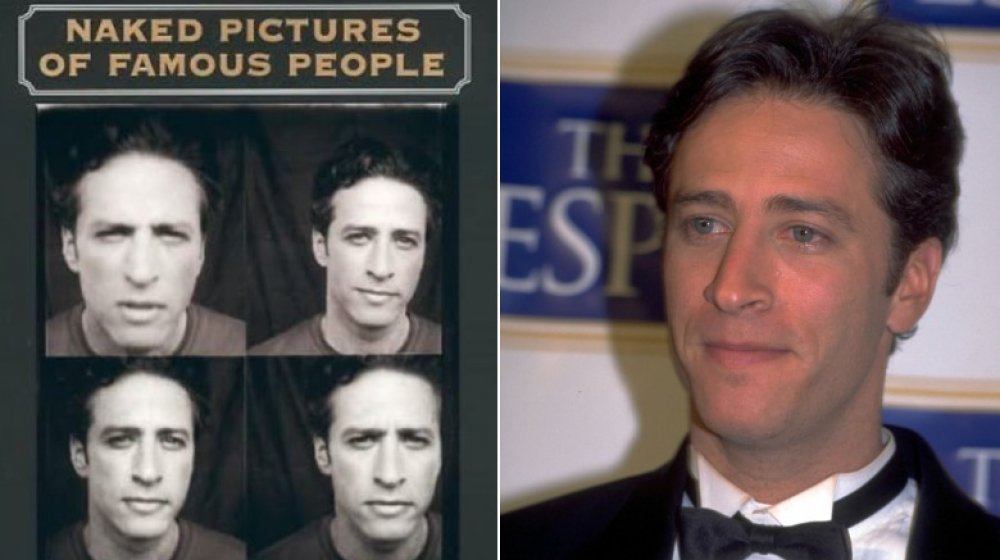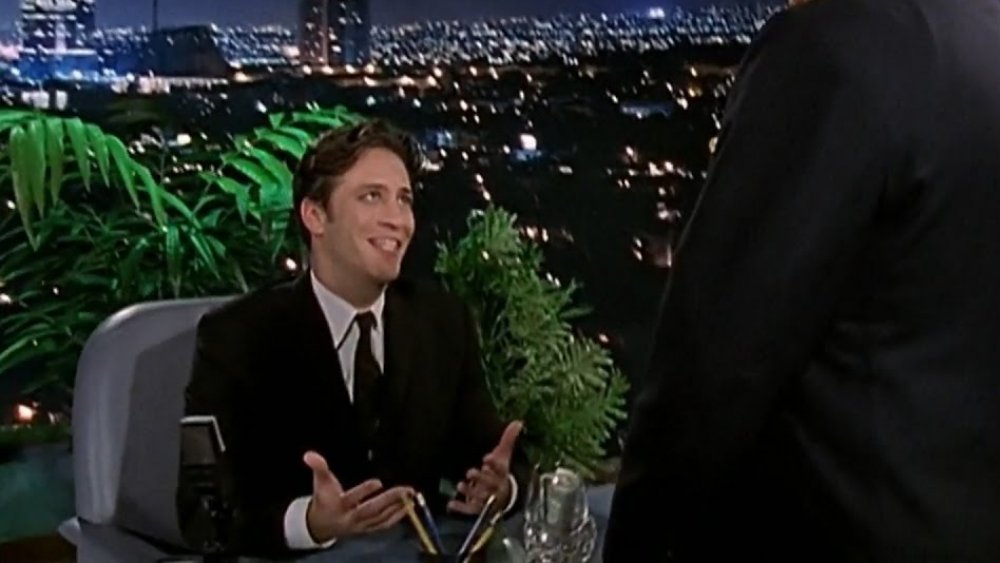What Jon Stewart Was Like Before The Daily Show
To most, Jon Stewart will always be the anchor of The Daily Show. Even though he abdicated the desk long ago, he'll always be associated with it, the same way Johnny Carson is associated with The Tonight Show to this day. He was the face and the voice of those frustrated with Washington, the news media, and the pundit class — so much so that he, against his wishes, became one of the most trusted news sources in America, as the New York Times reported in 2008.
In recent years, Stewart has dabbled in directing and still produces shows, most notably The Late Show with Stephen Colbert. He's also become a tireless advocate for 9/11 first responders and, as NPR writes, veterans who were denied benefits.
Of course, Stewart had a long career before The Daily Show — he's not even the first host. Gen Xers probably remember his show on MTV, rom-com enthusiasts might have seen his work in the mid-nineties, and longtime stand up fans might have seen him on the circuit when he first started. For many, though, what Stewart did before Indecision 2000 is something of a mystery. Let it be one no more: here's what Jon Stewart did before (accidentally) becoming the most trusted man in news.
Jon Stewart grew up in New Jersey
Jon Stewart wasn't born "Jon Stewart," but rather, Jonathan Stuart Leibowitz. He was born in New York to parents Don and Marian, with an older brother named Larry. According to Moment Magazine, they lived in Lawrenceville, a suburb of Princeton, New Jersey. Don worked for Princeton University, Marian was a teacher. They were, by all accounts, a normal, middle class Jewish family. Larry went on to become a major player in the stock market, at one point becoming an executive vice president of NYSE Euronext.
Don and Marian divorced when Jon was nine, which he took pretty hard. Jon had a complicated if not outright strained relationship with his father, according to the Guardian, which led to him going by his middle name, and eventually changing it to "Jon Stewart." The separation saw many changes, including Stewart's Bar Mitzvah being held at a local Jewish center instead of an upscale hotel like his brother's.
Stewart's sense of humor was evident from a young age, and perhaps inherited from his maternal grandfather Nathan Laskin. Marian once said that her father, who once owned a fur business in China, was "very funny" and made extra money as an entertainer during his youth. Stewart's high school English teacher, Selma Litowitz, was among the first to realize he could make a living doing comedy: Litowitz died of Parkinson's in 2005, and Stewart came back to his high school in 2001 to host a benefit for her.
Jon Stewart was a college soccer star
Stewart lived a classic college lifestyle during his time at William & Mary, according to Vulture. There was, however, one thing he excelled at: soccer. Al Albert, Stewart's soccer coach, described to ESPN a dedicated player who "wasn't the most technical or clinical player, but he could make things happen." Stewart was successful at the high school level and, in typical cocky freshman fashion, thought he'd make the team as a walk-on before getting relegated to JV. He made varsity his sophomore year, which he called "an opportunity that I never took for granted." Known by the nickname "Liebo," he played winger and midfield and was a productive player his three years on the team. His biggest moment was scoring the only goal in an away game against Connecticut, that helped launch William & Mary into the postseason.
In 1983, Moment Magazine writes that Stewart was recruited for the Pan American Maccabi Game, a lead up to the World Maccabiah Games, often known as the Jewish Olympics. His team had a record of four wins and one loss, winning the respect of the locals. Both Albert and his Pan Am teammates describe Stewart as the locker room joker who people could cut down teammates at a moment's notice.
Years later, William & Mary's soccer team created "The Liebo Award," given to the player who best effected team morale.
Bartending at a notorious punk club
Stewart returned to New Jersey in 1984 after graduating college and spent the next two years taking on odd jobs. These include working for the New Jersey Department of Health, sorting mosquitoes, and as a puppeteer for special needs children. He also spent time as a busboy, which (via The Week) inspired the name of his production company.
More notable was his time spent as a bartender. Some of his time was spent at a windowless bar off Route 1, called The Bottom Half. His more memorable and positive experience came at Trenton's legendary punk club, City Gardens. Stewart recounted his experiences at the club to Vulture, saying that he has a "fond memory of that place." He called it a "creative environment" that showed him "maybe there are other people who have a similar sense of yearning for something other than what they have now." He listed a litany of classic punk and hardcore bands he saw: X, GWAR, Joan Jett, Black Flag, the Butthole Surfers (who almost burned the club down), Bad Brains, and many more.
During his time there, he also invented his own drink called The Whack In The Head. It was, via The Daily Beast, a mix of an Alabama Slammer and a Long Island Iced Tea. Probably best not to try that at home.
Jon Stewart was a rising star in the comedy world
Around 1986, Stewart sold his car and moved to New York, to pursue a career in comedy. It took him months to muster up the courage to get on stage before booking his first gig. Debuting at The Bitter End, an iconic comedy club in the West Village, he was given the 1am slot and performed to weak crowd reaction. The booker, according to Moment Magazine, chalked it up to a rough crowd at a rough time, but recognized Stewart's talent and invited him back. Stewart spent the next few years honing his act and became a regular at Caroline's, another legendary New York comedy club. He also started going by "Jon Stewart" formally, partially because of his father, but also because emcees had a hard time pronouncing his last name.
Stewart's comedy during this era was similar to the political humor he'd become world famous for, but his presentation was markedly different. He wore leather jackets and took on a more irreverent tone, as the Los Angeles Times says, instead of the suits and frustration associated with his time at The Daily Show. He was the cool comic everyone wanted to be, or at least know.
Stewart, via New York Magazine, credits his March 1992 appearance on Late Night with David Letterman as his big break. Stewart was already a big star on the stand-up circuit, but his Late Night spot turned him into a big star, period.
Jon Stewart was friends with Anthony Weiner
Here's one of the better known pieces of Jon Stewart trivia: he was friends with former Congressman, and current registered sex offender, Anthony Weiner.
Weiner told CityScoops that the two met after college via mutual friends, as Weiner worked on the staff of then-Representative Chuck Schumer with one of Stewart's college soccer teammates. Stewart later shared a SoHo apartment with Weiner's then-girlfriend, and as such Weiner practically — though not officially — lived there. They all also shared a summer house in Delaware during the late eighties. One of their former housemates told the Washingtonian that, even though Stewart was the professional stand-up, Weiner was often the funniest guy in the house.
The two remained friends for years, which caused a problem when Weiner got caught up in his first sexting scandal in 2011. Stewart, stuck between going after his friend and mining what he saw as the once-in-a-lifetime comedy gold of a guy named "Weiner" sexting, spent over a week's worth of shows openly agonizing. Stewart apologized for going soft on Weiner in a segment mocking Weiner's own press conference, according to the Hollywood Reporter, during which Stewart's hand was badly cut due to a blender malfunction, in a bit gone horribly wrong.
Jon Stewart auditioned for Late Night in 1993
By 1993, Stewart was a rising star and one of the hottest comic properties in New York. By good fortune, a new opportunity arose: David Letterman was bolting to CBS, leaving his desk at Late Night vacant. As such, Stewart was a finalist for the spot, before losing out to Conan O'Brien.
An audition was held at the Hollywood Improv, and was attended by NBC brass. including Lorne Michaels and producer Jeff Ross (no relation to the comic of the same name). Bill Carter's book The War for Late Night lists the other participants as Allan Harvey, Paul Provenza, Michael McKean, Rick Reynolds, and Drew Carey. Stewart claims O'Brien was also there, though Carter indicates otherwise. Though Stewart was characteristically glib describing his rejection — claiming that Michaels stood up two minutes in to say "thank you" — Carter paints a more complete picture. Late Night producers met with NBC executives the next day and, while none of the comics stood out, Ross was privately most fond of Stewart. Michaels tried to get O'Brien for some time before and it was at that meeting he was convinced to try again.
Stewart was "bummed" (via Newsweek) about it at the time, but his later success on The Jon Stewart Show, and O'Brien's early struggles, led many to feel that NBC had chosen wrong. Case in point: New York Magazine ran a story, reprinted by Vulture, about Stewart in 1994, titled "The Man Who Should Be Conan."
Jon Stewart had shows on early Comedy Central and MTV
One of Stewart's first TV gigs, via the book Jon Stewart: A Biography, was co-hosting Short Attention Span Theater (aka SAST) on Comedy Central in early 90s. The show came out in the early and low rated days of Comedy Central, when the channel mostly showed comedy movies and stand up specials. SAST was something of a clip show, highlighting snippets from stand-up specials and scenes from movies shown on HBO and Cinemax. His work on this tiny channel got him enough attention to get snapped up by a bigger fish in the cable market: MTV.
Stewart was tapped to host You Wrote It, You Watch It in 1992. This was early TV work for both Stewart and sketch comedy troupe The State. The title summed up the premise of the show: viewers would send in sketch suggestions, and The State would perform them. It was canceled after one season due to low ratings. Stewart had the obvious quip about that: "You wrote it, you just didn't watch it!"
Even if the show didn't last, the show endeared him to MTV management, so much so that they started developing a talk show for him before You Wrote It, You Watch It was even canceled, according to the Los Angeles Times.
The Jon Stewart Show
The Jon Stewart Show debuted on MTV in October of 1993, and immediately became the network's crown jewel of live programming. It was a half-hour, fast-paced, casual show with an irreverent sensibility.
Stewart would bring on hip young actors, models, and just plain weirdos. Guests ranged from Quentin Tarantino, to William Shatner, to 80-year-old cheerleaders. Sketches included a reenactment of the OJ Simpson trial as a game of Clue, and Stewart having a psychedelic trip after licking a toad. The musical guests, in particular, were top notch: Warren Zevon, Sunny Day Real Estate, and Marilyn Manson, the last of whom rode off the stage after jumping onto Stewart's back. The show was an instant hit and quickly became the second highest rated show on the network behind Beavis and Butt-Head. Conan's turn on Late Night and The Jon Stewart Show started around the same time. O'Brien's tenure got off to a dismal start, and many reviews were quick to point out Stewart cultivated the Gen X following NBC wanted.
Viacom and MTV brought the show into syndication in 1994 to replace The Arsenio Hall Show. Syndication was the show's downfall. Viacom marketed the show poorly, according to Fast Company, and the program's existing audience was a bit too niche for major networks, so the show was cancelled ten months later.
Jon Stewart had contracts with Miramax and Worldwide Pants
The end of his talk show wasn't the end of his career, obviously, but it did lead to a strange chapter in his career: he signed several contracts that promised big dividends but ultimately fizzled out. A mere four months after The Jon Stewart Show shuttered, Miramax signed Stewart to a three-year movie deal. The original plan was for him to appear in two movies a year, and produce his own projects, but both of those promises fell short. He only appeared in four Miramax movies total: Wishful Thinking, Since You've Been Gone, The Faculty, and Playing By Heart. None of his own projects went anywhere.
NBC openly showed interest in Stewart in 1996, according to an old Entertainment Weekly piece. Rumors suggested he'd take over Later at 1:35am and replace Greg Kinnear. Perhaps as a response, David Letterman's Worldwide Pants signed Stewart to a TV deal with the promise of his own 1:35 show on CBS. This also never came to fruition, though he did substitute for Late Late Show host Tom Snyder on occasion. In the meantime, he made a series of guest appearances on various sitcoms, including a memorable appearance as Matthew's not-quite-twin brother on NewsRadio.
Jon Stewart met his wife ... and almost blew it
One of the few projects to come out of the Miramax deal was Wishful Thinking, a cookie cutter nineties rom-com, also starring Drew Barrymore and Jennifer Beals. It was through working on that movie that Stewart met his future wife, Tracey McShane.
Stewart recounted to Larry King that someone working on the film offered to set him up with her roommate. After calling and getting her number, Stewart wrote it on a dollar bill. He later accidentally spent that specific dollar on a pack of cigarettes. As such, he didn't call back — this was in the days before cell phones were universal, so everyone still had to memorize numbers — until he got his hands on a call sheet. He used this to find the woman who set them up in the first place and reconnect.
Stewart and McShane dated for four years. He proposed to her via a crossword puzzle custom made by New York Times master crossword editor Will Shortz, according to the Los Angeles Times.
Jon Stewart wrote a book
While he was twisting in the wind and waiting for one of his deals to work out, Stewart did something a lot of people with too much time on their hands do — he wrote a book. One with a salacious and deliberately misleading title: Naked Pictures of Famous People.
Released in 1998, the book is something of an anomaly, compared to the comedy books being written by stand-ups in the nineties and 2000s. Most others, such as Chris Rock's Rock This or George Carlin's Brain Droppings, were more-or-less text versions of their stand up routine. Others were standard biographies or tell-alls, like Roseanne Barr's My Life. Instead, Naked Pictures of Famous People is entirely original sketches and essays, reminiscent of classic comedy books from the sixties and seventies. Indeed, Entertainment Weekly called it "on a par with Woody Allen's Without Feathers and Steve Martin's Cruel Shoes."
The book includes stories ranging from offhandedly goofy to outright tawdry. "Vincent and Theo on AOL" shows the transcripts of Vincent Van Gogh trying to talk to his brother via an AOL Chat Room. "Adolf Hitler: The Larry King Interview" imagined an interview between a reformed Hitler who faked his own death and King. "The New Judaism" featured Stewart laying out Judaism's history and how it can survive, including the addition of a mascot named "Jewey" who is just a Jewish version of Joe Camel. The book was a bestseller.
Jon Stewart was a guest host for talk shows, real and fake
Stewart getting another late night spot always felt more a case of "when" than "if." As such, Stewart spent the rest of the nineties guest hosting shows, both real and fake, and getting dogged by rumors regarding if he was taking over the hosting spot.
Stewart, as part of his Worldwide Pants contract, occasionally filled in for Tom Snyder on The Late Late Show, including a full week of shows in October of 1996. Stewart was also a recurring guest star on The Larry Sanders Show, HBO's sitcom about the goings-on of a late night talk show. Stewart played a version of himself who was a frequent guest host, always threatening to take over the show. According to the Washington Post, this led to constant speculation that Stewart was going to take over either show. While he didn't land Late Late, though, the program did indirectly get him onto The Daily Show. Snyder announced his retirement in 1998, and Craig Kilborn, the original host of The Daily Show, wanted to leave Comedy Central and take over the network TV posting. This left an opening for Stewart on Kilborn's program, and thus, he was hired onto The Daily Show. This was ideal, because Stewart wanted a new gig, but as Broadcasting & Cable quoted him saying at the time, he didn't want to push anybody out.
And thus, from 1999 onward, The Daily Show would forever be his legacy.
